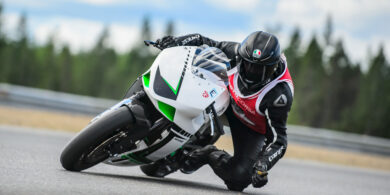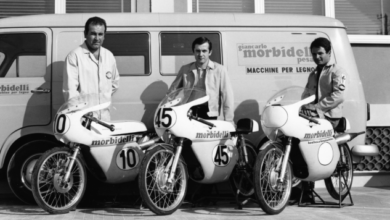Polaris shows 2005 sleds
After flying in a technological holding pattern for two seasons, Polaris Industries released its much-rumored A-arm snowmobiles for the 2005 model year.
The machines, called the Fusion 900 and 900 RMK, are Polaris’ new flagships — and an indication of the way the company’s design will continue in the future.
“The Pro X will fade away as we move forward, as well as the XC SPs,” said Craig Wilfahrt, snowmobile product manager for the short track machines.
The Fusion 900 was meant to meet four goals, Wilfahrt said. Designers, he said, wanted a machine that adapted to riding style, provided industry-leading ride and handling; was high-performance; and had an aggressive, muscular style.
He said those goals were met with a new Rider Select adjustment system, a new rear suspension that blends the features of the M-10 and the Pro X; the Liberty 900 engine; and sport-bike type styling.
Liberty 900
“We look at the 900 segment as an area of growth,” Wilfahrt said, noting that machines with more than 130 hp have increased in sales in recent years.
A new 866cc Liberty twin-cylinder two-stroke engine powers the Fusion and 900 RMK. The big twin delivers a broad torque curve. The engine is mounted in a laydown design with the cylinders tilted back 22 degrees. The rearward tilt allows for lower mounting and toward the center of gravity of the machine.
According to Polaris, it has 11 percent more peak power than its 800 Liberty twin and 13 percent more torque. Peak horsepower is at 7500 rpm.
The engine utilizes a forward intake and exhaust design, a high flow intake with new reeds, solenoid-controlled variable exhaust, cylinder decompression, a 400 watt alternator, Polaris Electric Reverse Control (PERC), Detonation Elimination Technology (DET), a high flow cooling system and more.
It also utilizes a Cleanfire fuel injection
system, which uses one injector per cylinder and are attached to the crankcase. The fuel is injected directly into the crankcase and controlled by an ECU. The batteryless system automatically calibrates and adjusts for temperature, altitude and throttle position, among others.
The Fusion
There’s not much that isn’t new on the Fusion 900. “IQ” pops up several times in new componetry: the IQ chassis, the IQ A-arm front suspension and the IQ rear suspension.
The Fusion is about adjusting to fit almost all riders, riding styles and terrain. The handlebars adjust along a 6-inch, seven-position arc that sets the driver in different driving positions and body mass locations. Using a pushbutton at the handlebar base, they can adjust to an “attack” mode (high), “control” (middle) and “comfort” (low).
“How you move the driver will change the behavior of the sled,” Wilfahrt said.
Part of the Rider Select system includes a new seat that is 6 inches taller than the XC SP seat. The seat is contoured in front for aggressive riding and standing and flatter at the rear for more comfort.
The tunnel is straight compared to the dual-angle tunnel on the EDGE sleds. It incorporates Polaris’ perimeter cooling system, wide running boards with integrated traction and pressed-in tunnel protectors. The footrests are flatter and there is an integrated rear cooler. To aid in cooling, Polaris added a radiator at the nose of the engine compartment. Engineers say it will help cool the sled in low snow conditions or at prolonged low speed operation.
Wilfahrt said the machine was designed with service access in mind.
The IQ rear suspension offers 12 inches of vertical travel, which Wilfahrt said is more usable travel than the 13 inches on the XC SPs. Polaris says it offers the best of the EDGE and Pro X designs, and improves stutter bump absorption and resists bottoming. The suspension weighs about 10 pounds less than previous designs. It has a new front torque arm and a new Fox PS5 rear shock.
Up front, the IQ A-arm independent front suspension offers 10 inches of travel. The IQ A-arm suspension delivers less bottoming and better handling, according to Polaris. It comes with Ryde FX shocks standard. It has near zero scrub and less steering effort.
New Accu-Track 2 skis are a combined 1.5 pounds lighter than previous designs. They have a deep keel and come standard with dual runners. However, the skis accept single runners without any modification.
In overall weight, it should be comparable to the 800 XC SP.
There are three lockable storage areas — one at the back of the seat and one above each footwell. There are removable side panels that offer access to the engine compartment. The headlight is brighter and the new rear taillight, with wrap-around side lighting, matches the look of the headlight assembly.
Polaris also added a high-tech digital/analog gauge on the dashboard. The speed and rpm can be toggled between digital and analog. Also programmed into the gauge is a host of other functions, which include a fuel gauge, two odometers, a clock and hour meter, battery voltage, oil level, service intervals and maximum rpm and speed memory recall.
The marketing theme on the Fusion 900 is “controlled aggression,” Wilfahrt said, and market research groups helped the company determine if it was meeting its style goals..
It’s also not going to market the front suspension as “A-Arm,” he said. Instead, it will be pushed as the IQ front suspension.
900 RMK
Polaris was only going to make one IQ style — until market research showed strong geographical preferences to different styles. Through that, the 900 RMK was born.
“It’s totally purpose-built for the mountains,” Pat Bourgeois, external relations coordinator, said.
Flotation was identified as a key feature, and the machine was designed to flow through the snow, he said.
It has some similarities to the Fusion 900: the same engine, the same digital/analog speedometer, the Rider Select seating and some suspension concepts.
In front is the IQ RMK A-arm front suspension with 9 inches of travel. Ryde FX shocks help cushion the bumps. The ski stance is fixed at 41 inches center to center.
The rear suspension is an updated version of the Escape rear skid. The track lengths vary from 151 to 159 to 166 inches. The tracks are 15 inches wide. The 151- and 159-inch long tracks come with 2-inch tall lugs, while the 166-inch long track has 2.4-inch tall lugs. The 166-inch long track is based on Polaris’ Series 4 track design. Polaris says it provides better bite to lift the sled on top of the snow. Also, the track is rated to 70 mph. That means there’s a potential for durability issues during prolonged use at high speeds.
Other mountain-specific designs include an RMK-specific belly pan and hood, hood channels that push the snow down and out around the rider and hood vents that are angled back to prevent snow accumulation.
The headlight styling has an aggressive look. There’s an option of adding a projector beam to the center of the headlight assembly on the 900 RMK. It projects a beam of light up to 400 feet in front of the snowmobile.
Under the seat is a new tunnel with narrow running boards. The running boards offer stamped traction and boot grips. The tunnel is straight, which reduces weight and offers more clearance between the track and tunnel. Tapered side panels allow drivers to lean farther across the sled, thus potentially improve sidehilling. The seat is also removable with underseat storage.
Other Machines For 2005
The 900 Fusion and 900 RMK are the only additions to the Polaris lineup so far for 2005.
Other changes include discontinuing 15 models from its lineup. For 2005, all of the Pro Xs and Pro X2s are history as well as the Pro XR, Frontier Classic, 700 and 800 Classics, Sport Touring, 700 EDGE Touring, 700 Switchback and Indy 340.
Wilfahrt said that the company didn’t see enough volume in the Pro X series. “It was outsold [by XC SPs] by five-to-one in some states,” he said. “It was a business decision. The IQ-chassis machines will be the new Pro X.”
The Frontier Classic was eliminated for a similar reason. “We just weren’t seeing the volume in it like we were for the Frontier Touring,” he said. “It lacked the four-stroke punch of the [Yamaha] RX-1.”
Returning are the 120 Pro X; Super Sport; Indy 500; 500, 600, 700 and 800 XC SPs; 340, 550, 500 and 600 Classics; 340 EDGE Touring; Trail Touring; Trail Touring Deluxe; 600 and 800 EDGE Touring; Frontier Touring; Switchback 600 and 800; and Widetrak LX.
All the XC SPs get the Polaris Adjustable Seat System (PASS) standard as well as a quiet chain tensioner. The tensioner helps eliminate the high-pitched chaincase noise that is noticeable when braking or decelerating. There’s also a new stainless steel exhaust valve on the 800 engines.
In the mountain segment, the Trail, 600, 700 and 800 RMK in the EDGE RMK chassis return with modest changes. Some of those updates include lighter front and rear suspensions; a 909 gear added to the 600 twin for better cooling; a polished shaft on the TEAM driven clutch; a new driven clutch spring for better performance and consistency and a quiet chain tensioner that reduces chaincase noise. psb




